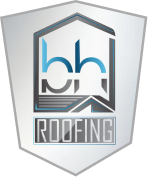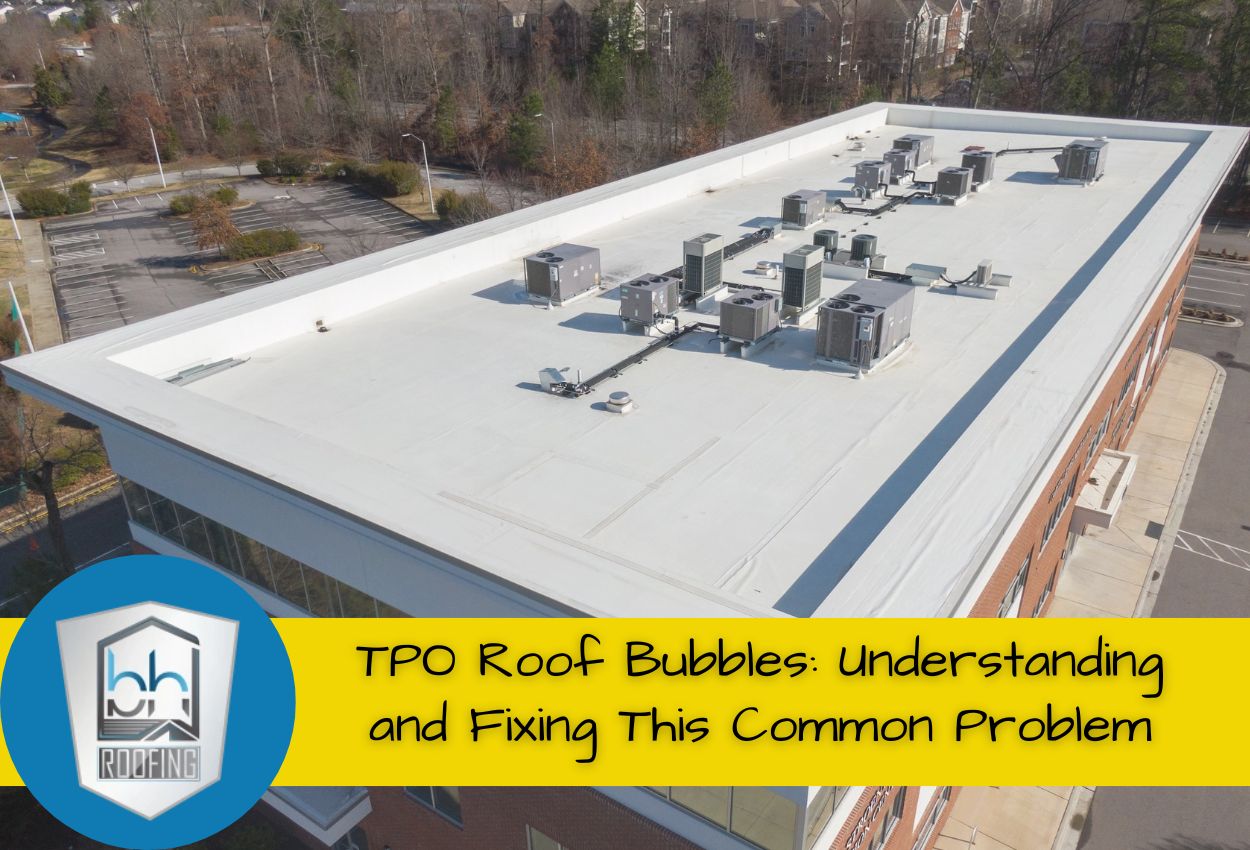TPO roof bubbles are raised areas or blisters that form on thermoplastic roofing membranes, creating noticeable bumps across the surface of commercial buildings. These bubbles occur when air or moisture becomes trapped between the membrane layers or between the membrane and the roof deck during installation. The trapped substance expands and contracts with temperature changes, causing the material to lift and form distinctive bubble-shaped pockets.
TPO bubbles often stem from poor installation practices, inadequate surface preparation, or moisture present during the membrane application. Single-ply roof membrane issues like these compromise the protective barrier that keeps water and weather elements away from the building structure. When bubbles appear, the affected areas become weak points where water can penetrate and cause extensive damage to insulation and decking materials.
Addressing commercial roof bubble damage quickly prevents minor problems from causing structural concerns. Understanding what causes these formations and recognizing early warning signs allows building owners to take action before the damage spreads. Preventing bubbles on TPO roofs starts with proper installation techniques, but knowing repair options helps protect existing roof systems from complete failure.
Common Causes Behind TPO Membrane Bubbles on Your Commercial Roof
TPO membrane bubble causes typically trace back to mistakes made during the original installation process. Improper adhesive application ranks among the most frequent problems, occurring when contractors apply too much or too little bonding material between membrane layers. Surface preparation issues also contribute significantly to bubble formation, particularly when installers fail to remove debris, dust, or existing moisture from the substrate before applying the new membrane. These single-ply roof membrane issues create weak bonds that allow air pockets to form and expand as the roof heats up during warmer months.
Environmental conditions play an equally important role in creating bubbles on thermoplastic roofing systems. Moisture trapped beneath the membrane during installation or from leaks in the existing roof deck expands when temperatures rise, pushing the flexible TPO material upward. Temperature fluctuations cause the membrane to expand and contract repeatedly, which can separate poorly bonded sections and create new bubble formations. Water vapor moving through the roof assembly from inside the building can also condense under the membrane, creating pockets that worsen over time. Understanding both TPO roofing installation defects and environmental triggers helps property owners recognize why commercial roof bubble damage occurs and emphasizes the importance of prevention measures during installation and maintenance.
Different Types of Bubble Damage on TPO Roofing Systems
Recognizing the difference between minor surface bubbles and serious membrane separation starts with visual inspection of the affected areas. Small bubbles typically measure less than 2 inches in diameter and feel soft when pressed gently with a hand. These minor formations often contain trapped air rather than water and may not immediately threaten the roof’s integrity. Larger bubbles spanning several feet indicate more severe TPO roofing installation defects where significant membrane separation has occurred. Property owners should look for bubbles that feel firm or contain liquid, as these suggest moisture infiltration beneath the surface and require professional attention.
Property owners can assess bubble severity using simple examination methods before contacting roofing contractors, such as:
- Walking the roof surface to note bubble locations and sizes provides valuable information about the extent of single-ply roof membrane issues.
- Pressing gently on bubbles reveals whether they contain air or water, with water-filled formations indicating more serious problems.
- Taking photographs from multiple angles documents the damage for contractor consultations.
- Checking for patterns in bubble locations often reveals systematic causes such as poor seam bonding or inadequate fastening.
- Examining the membrane around bubbles for signs of cracking, thinning, or discoloration indicates whether the material has already begun failing.
These assessment techniques help building owners communicate effectively with roofing professionals about TPO roof bubble prevention and necessary repairs.
TPO Roof Bubble Repair Methods That Actually Work
The size of the bubble significantly impacts the repair techniques used. Small bubble repairs for TPO roof systems begin with cutting a small incision in the affected area to release trapped air or moisture. Contractors typically make a precise slit at the bubble’s lowest point, allowing contents to escape while minimizing membrane damage.
After draining the bubble completely, professionals clean the exposed area thoroughly to remove any contaminants or debris that could interfere with adhesion. A specialized TPO adhesive or bonding agent is then applied beneath the membrane, and the material is pressed firmly back into place. The repair is completed by sealing the incision with a TPO patch that overlaps the cut area by several inches on all sides, creating a watertight barrier. It is important to understand that these patch-based solutions work effectively for bubbles smaller than 6 inches in diameter and are only meant to address TPO bubbles that do not require extensive membrane replacement.
Large-scale bubble repair approaches are necessary for extensive damage covering significant portions of the membrane. Professional restoration methods for widespread single-ply roof membrane issues involve removing entire sections of compromised TPO material rather than attempting individual bubble repairs. Contractors cut out the damaged membrane sections, inspect and repair the underlying substrate if moisture has caused deterioration, and install new TPO material that integrates seamlessly with the existing roof system. This comprehensive approach corrects TPO roofing installation defects that created multiple bubbles across broad areas. For bubble prevention on repaired sections, professionals ensure proper substrate preparation and use heat-welding techniques to bond new membrane sections securely to surrounding materials, eliminating future bubble risks.
Prevention Strategies to Stop Future TPO Roofing Bubble Problems
Proper installation practices are the foundation of effective TPO roof bubble prevention on commercial buildings. Contractors must verify that roof substrates are completely dry before applying TPO membranes, as any moisture present during installation becomes a primary cause of bubbles. Surface preparation requires thorough cleaning to remove dust, oils, and debris that interfere with adhesive bonding. Adhesive application should follow manufacturer specifications precisely, with consistent coverage across the entire surface to prevent weak spots where air can become trapped.
Quality control measures during installation include regular inspections of seam welds and adhesive bonds before covering each section with additional materials. Professional installers should monitor weather conditions and avoid applying membranes during high humidity or when rain is forecasted, as environmental factors directly impact bond quality and contribute to single-ply roof membrane issues.
Regular maintenance routines significantly reduce the likelihood of commercial roof bubble damage developing over time. Property owners should schedule professional roof inspections twice annually to identify early signs of membrane separation or small bubbles before they expand. Maintenance teams should examine seams, penetrations, and previously repaired areas where TPO roofing installation defects most commonly appear. Additionally, cleaning debris from the roof surface prevents water pooling that can seep into minor membrane imperfections and create bubble formations. Documenting inspection findings over time tracks patterns that suggest underlying problems with the roofing system.
Overall, establishing a proactive maintenance schedule allows building owners to address minor concerns immediately rather than waiting until extensive repairs become necessary.
Recognizing When Professional Help is Necessary for TPO Bubble Repairs
Certain warning signs indicate that TPO roof bubbles require immediate professional intervention rather than temporary patch solutions, including:
- Bubbles larger than 12 inches in diameter typically signal extensive membrane separation that needs specialized repair equipment and expertise.
- Water-filled bubbles present urgent concerns because moisture has already penetrated the roofing system and may be damaging insulation or decking materials beneath the surface.
- Multiple bubbles appearing across different roof sections suggest systematic TPO roofing installation defects that temporary fixes cannot adequately address.
- Bubbles located near seams, penetrations, or roof edges pose particular risks because these areas already experience higher stress and vulnerability to weather infiltration.
- Commercial roof bubble damage accompanied by visible membrane cracking, thinning, or discoloration indicates material deterioration that requires complete section replacement rather than simple patching.
- Bubbles that continue expanding despite cooler temperatures suggest active water accumulation rather than simple thermal expansion.
- When building occupants report interior leaks or water stains near bubble locations, the membrane has already failed its protective function and needs expert assessment.
Property owners should also seek professional contractors when bubbles reappear after attempted repairs, as recurring single-ply roof membrane issues point to underlying substrate problems or moisture sources that DIY methods cannot resolve. Roofing professionals possess diagnostic tools like infrared cameras and moisture meters that identify the full extent of damage invisible to surface inspections, revealing whether trapped moisture extends beyond the visible bubble area.
When interviewing roofing contractors about bubble repair capabilities, building owners should ask specific questions about their experience with thermoplastic roofing systems. Requesting examples of previous TPO membrane bubble repairs helps verify the contractor’s familiarity with these specific single-ply roof membrane issues. Property owners should inquire about the diagnostic methods the contractor uses to identify the causes of TPO membrane bubbles and assess whether underlying substrate damage exists. Questions about the proposed repair methods reveal whether the contractor plans temporary patches or comprehensive solutions that address root problems. Clarifying what warranty coverage applies specifically to bubble repairs protects building owners from recurring expenses if problems reappear. Asking whether the contractor is certified by TPO membrane manufacturers demonstrates their training in repair techniques that maintain material warranties and prevent future bubble issues for repaired areas. Professionals can also recommend proactive care to reduce the risk of TPO bubbles forming over time.
Protecting Your Investment Through Proper TPO Maintenance
Addressing bubble formations promptly brings many long-term advantages that extend well beyond the immediate repair area. Property owners who resolve TPO membrane bubble causes early prevent minor surface damage from progressing into complete membrane failure that requires replacement. Each bubble represents a weak point where the protective barrier has separated from its substrate, creating vulnerability to water infiltration and structural deterioration. When left unaddressed, these single-ply roof membrane issues allow moisture into insulation layers and roof decking, leading to rot, mold growth, and compromised structural integrity. Regular maintenance that identifies and repairs bubbles before they expand saves commercial buildings from extensive interior damage and business interruptions caused by leaks.
Commercial roof bubbles that receive prompt professional attention preserve the overall roof system for decades beyond what neglected membranes achieve. TPO roofing systems properly maintained against bubble formation routinely reach their expected service life of 20 to 30 years, while those with unresolved TPO roofing installation defects often fail within half that timeframe. Proactive bubble prevention measures maintain the membrane’s reflective properties and structural integrity, ensuring consistent performance throughout the system’s lifespan.
Energy efficiency improvements are another compelling benefit of maintaining bubble-free TPO membranes on commercial structures. Bubbles create air gaps that reduce the roof’s thermal performance, allowing heat transfer that increases cooling costs during warm months. Properly sealed thermoplastic roofing maintains its designed R-value, keeping building interiors comfortable while minimizing energy consumption. The reflective white surface of TPO membranes performs optimally when smooth and properly bonded, deflecting solar radiation that would otherwise penetrate the building. Resolving commercial roof bubble damage restores this energy-saving capability, delivering measurable reductions in utility expenses that accumulate substantially over the roof’s service life. By maintaining their TPO roof, property owners benefit from long-lasting protection, energy savings, and fewer repair needs caused by unaddressed membrane bubbles.
Resolve Your TPO Roof Bubbles Today with BH Roofing
If you’ve noticed the warning signs of TPO roof bubbles on your commercial property, don’t wait for the damage to escalate. BH Roofing can diagnose and repair TPO membrane bubbles, ensuring your roofing system remains intact and functional. From minor patches to complete membrane replacement, our expert team is equipped to handle all levels of bubble damage effectively.
Ignoring TPO roof bubbles can lead to severe structural issues down the line. Take action today to protect your investment and maintain the integrity of your building. For professional TPO roof bubble repair that you can trust, call BH Roofing at (210) 267-9029. We offer comprehensive solutions tailored to your specific roofing needs, ensuring long-term durability and performance.


